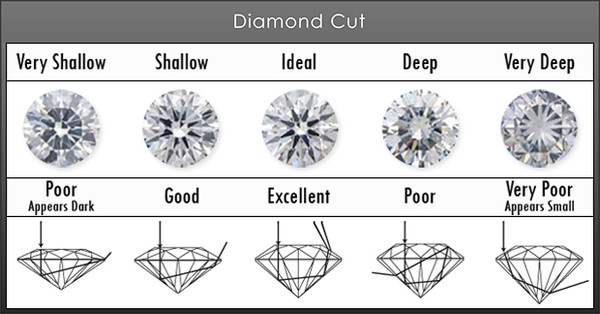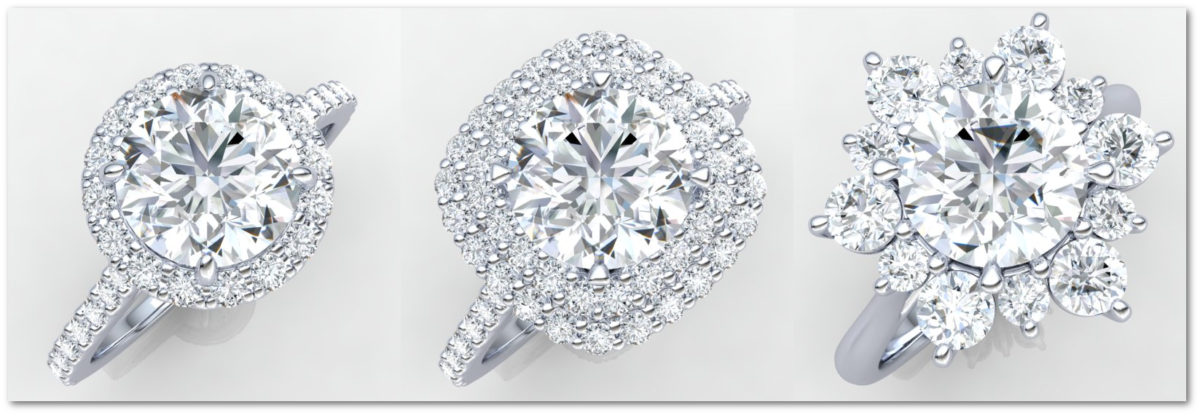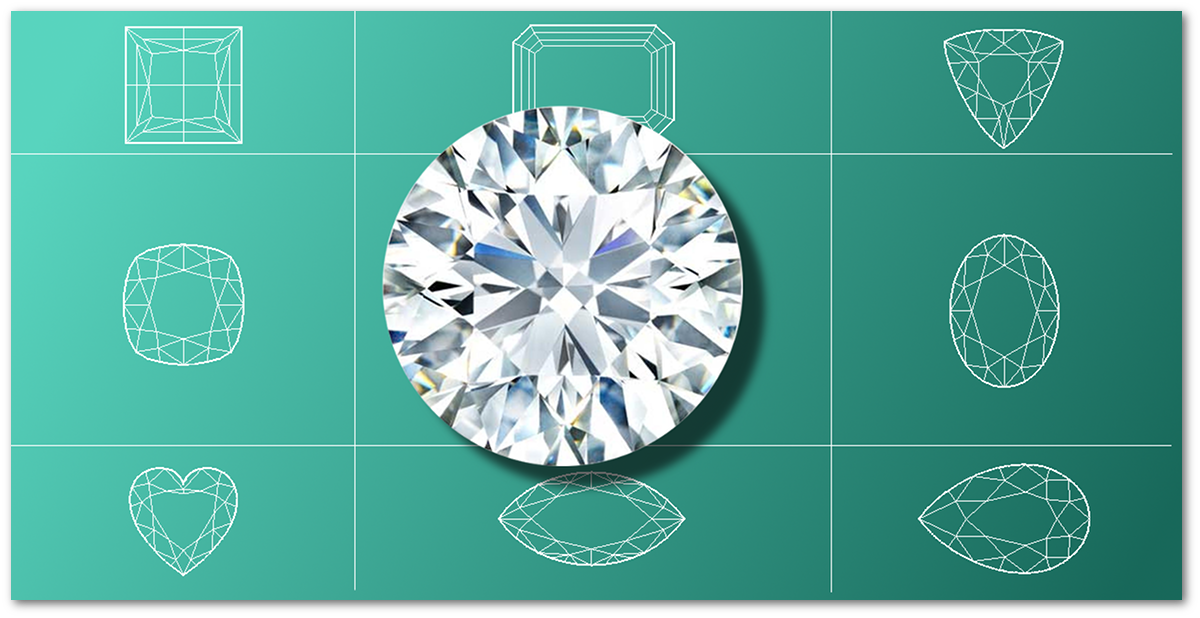
No boring history introduction here. We’ve got bigger things to do.
You’re about to dig into what makes round diamonds a fantastic diamond shape choice for an engagement ring. I’ll help you understand how pricing works, and show you specification combinations that optimise your budget – whatever it is. We’ll also talk about unique design opportunities a round diamond brings to the table.
At the end of the day the whole journey of creating the perfect diamond engagement ring should be comfortable and a memorable milestone.
Let’s defog the world of round diamonds.
Diamond Shapes
You get a ton of interesting and different diamond shapes, but the ten shown above are the most common.
The best sellers for the past 12 months internationally have been:
- Round
- Cushion
- Oval
Round diamond sales accounted for over 60% of diamond sales. Vastly outselling all the other shapes combined.
Why?
Think of a ring on this lady’s finger that would bring pick up lines to a screeching halt… boom.
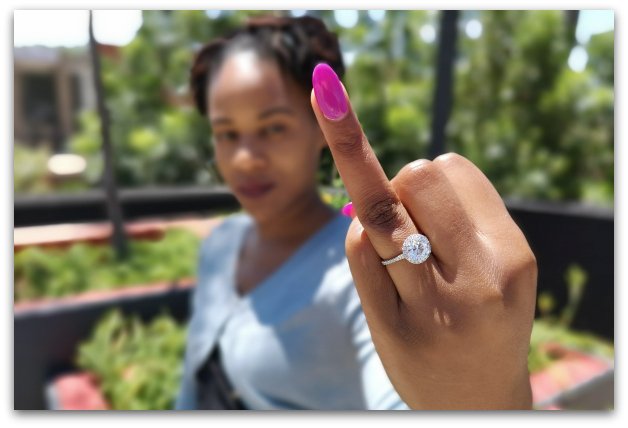
Engagement rings as a symbol undeniably lean towards diamonds… and almost just as strongly to them being round.
Saying a round is the “classic” diamond shape is not 100% accurate. I’ll bet you my dog, Raphael, your great-great-grandfather did not propose with a round diamond ring. They’ve only got these SOB’s round for about 80 years. But round is undeniably the quintessential diamond choice for an engagement ring and does carry with it a degree of iconic status. To the majority of people that is.
Just a note: I encourage everyone to browse and consider other diamond shapes as well. Any diamond shape (except a horse-head) can also be set-up to ensure someone looks very engaged. If you take a look at our work on Instagram or Facebook you’ll see the options are endless.
Isn’t a round diamond a bit too popular or common?
Is salt? Is a cross pendant?
It’s what you do with it… and what it means to you. That’s all that matters.
I’ve never crossed paths with a lady who hates a round diamond. True story.
That makes it a very safe bet for gents on solo-missions since the shape is extremely versatile design-wise and can therefor be redesigned into a rendition of his new bride-to-be’s perfect engagement ring, if need be.
It has stunning life/fire/brilliance and a stately sense of presence when set into a luxurious engagement ring. There’s a reason why it’s the number 1 choice of diamond shape.
Sweet-spot specifications to make your round diamond look great.
Carat: The (very important) size of the diamond.
Nothing upgrades the look of an engagement ring as much as a larger diamond.

That doesn’t have to come at the expense of compromising other specifications like the clarity, colour or quality of the craftsmanship exemplified in the diamond’s cut.
This is all about optimising how much diamond you get for your budget.
Recommended post; Which Diamond Shape Appears The Largest?
Colour.
Most couples want a diamond to appear white. And that’s just fine.
Colour grades are really misunderstood and internet colour charts make changes in colour look bizarrely severe.
Round diamonds are the least fussy when it comes to colour. The facet layout distributes colour very evenly and doesn’t emphasise overtones. So, a “J” colour round diamond looks whiter than a cushion or oval shape of the same colour.
Diamond colours range from “D” all the way down to “Z”. As you slide down the alphabet the colour of the diamond turns from colourless to yellow or brown in tiny increments. It’s very hard to tell 2 adjacent diamond colours apart in non-laboratory lighting. That gives you a bit of wiggle-room to work with.
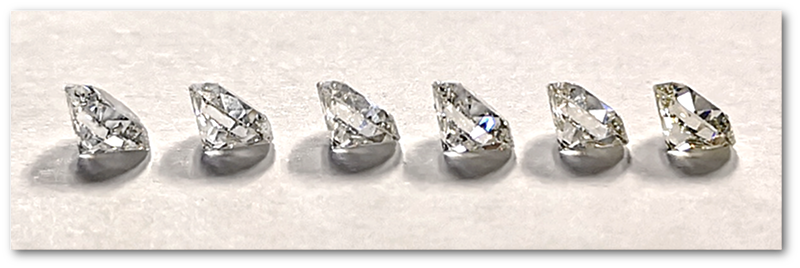
*In this image you have an F colour followed by H, I, L and then T. Do you see how slow and faint the progression is?
D-E-F colours are your high-end bracket. Yes, they’re as white as it gets… but they’re indistinguishable in colour from another unless you have sterile white light and very experienced eyes. There’s nothing wrong per se with opting for the crème de la crème D colour, but your investment over F won’t be visible. Unless you find yourself in a cost no object situation draw the upper line at “F”.
G-H: This is the premium category, and usually my highest recommended colour range. In normal light they’re still piercingly white, but don’t carry the high premium of D-E-F colours. Some internet colour charts show these as having some type of yellow tinge… that’s just rubbish. See some comparisons in this range here (link) or visit us for coffee to see for yourself.
I-J: This is the Goldilocks zone. These two colours set up white in platinum, palladium, rose gold and yellow gold. They’re priced very well and really give you a chance to up the size without any obvious visual compromises on colour. Strong blue fluorescence will also increase the perceived colour of these diamonds. For more on the amazing impact that fluorescence has on the perceived colour of a diamond head over HERE. Many of our 2,00ct engagement rings you see on social media are set with I and J colours.
K-L-M colours are surprisingly white and some people actually like the tiny bit of warmth these colours carry. They do have a slight undertone of colour, but they’re far from brown or yellow. These colours still set up white in rose and yellow gold. The coloured metals mask the colour of the diamond amazingly well.
Diamond colours that have an unapologetic yellow tone are absolutely beautiful and at least worth taking a look at. They’re something different altogether. Do yourself a favour and take a look at some fancy yellow diamonds if you’re open to something unique.
Clarity – Grade: Based on the type, location, number of, and size of natural impurities in a diamond.
All diamonds have impurities. Some you can see with the naked eye, others not. At all.
Diamond grading laboratories issue their grade on clarity at 10X magnification. You and me… we see at 1X. Another bit of wiggle room. We’re making some progress.
If a diamond is free from imperfections and inclusions when viewed with the naked eye – that’s good enough.
The following clarity ranges show up to what size diamonds will be eye-clean.
Colour and size upgrades offer way more visual improvement than maxing out clarity. That’s where your budget should be working.
If you’d like to understand the differences in charities I recommend you read “How do VS and VVS2 Clarities Compare?”.
Issuing a clarity grade is just a matter of a gemologists opinion, and unfortunately, some grading laboratories have treated certain large customers “favourably”.
There have been major scandals and exposes where certain grading laboratories overstated the characteristics of a diamond greatly on the grading report and thereby trick people into thinking they’ve purchased a much higher quality diamond than they actually have. Over-grading can easily double the asking price of a diamond. That’s why a bargain basement diamond is never a good idea.
Stick to diamond graded by the GIA, HRD, AGS and in South Africa, the DIA does a great job. The certificates are accurate, consistent and strict.
Cut: The most important “C”.
Diamond cut is often confused with the diamond shape (Round, oval, square).
A diamond has very special light reflection and refraction characteristics. You can think of a diamond’s facets (sides) as internal mirrors that reflect light internally to and from the diamond’s environment.
Through decades scientists have experimented with the optimal placement and proportions of diamond facets. The modern brilliant cuts have been designed to ensure that a diamond optimally reflects light when cut to these determined proportions and dimensions.
Proper cut = optimal sparkle/life/fire.
Through a series of complex measurements and comparisons a diamond grading laboratory determines how close a diamond has been cut to these predetermined “ideal” proportions. This grade is then referred to as the cut of a diamond;
- Excellent: Perfect.
- Very Good: Go for it. Indistinguishable from Excellent cut to 99% of eyes.
- Good: Very broad grade. Some are fine some look terrible. Rather avoid.
- Fair: Avoid.
- Poor: No.
You can have the highest known quality diamond – if it’s poorly cut it looks like nothing more than a dull piece of glass.
Imperfections in diamonds are also much more visible in poorly cut diamonds. When a diamond is properly cut the sparkle and life of the diamond easily masks minor imperfections. When it’s poorly cut – most specks and imperfections are visible.
There is never a reason to compromise on the integrity and quality of the cut. No colour, size or clarity can save a poorly cut diamond.
Before we move on to the design section – if you have any diamond related questions, I’m an email away.
Recommended Blog: “11 Ways to Ensure You’re Buying A High Quality Diamond (Including Checklist).
“Things that make designing with round diamond awesome.” – By Nadine, a designer here.
One of the best characteristics we would like to illustrate is how versatile a round diamond can be by showing some designs. Keywords here would be versatility, adaptability, and possibility.
Talking about versatility of round diamonds we are pointing out the ability to adapt or be adapted to many different styles of designs.
In the first three images observe how the center stone stays the main focus and the diamonds surrounding it adapts to it, enhancing its brilliance and its perceived size. This encirclement of small diamonds is called a halo.
Thinking of a solitaire setting and adding a halo to trace the outline of the stone.The halo adds a simple something extra to the center diamond to enhance its brilliance and boost the perceived size of the center stone. In design terms the center diamond appears bigger and still stays soft on the eye.
The Jaimee is an Illusionist. She has a round center diamond but with a double cushion halo.
With the strategic use of claws, the center stone is nicely nestled in the cushion halo, she appears more complex and visually represents bigger.
This is our classic cluster, Ida. She likes to balance it out with a variety sizes of the same cut. Mediums and smalls waltz around the center stone, all done to show the interesting composition different sizes of diamonds can make.Here you can get away with a more complex design around the stone as it has no geometrical anomalies.
Below we are going to take three different ladies, slightly turn them to the side to observe what other possibilities we have when it comes to using a round diamond as the center stone.
This is the quintessential engagement ring.
Classic and simplistic she grasps on to the center diamond with six claws and elegantly brings the design together with a tapered band. This rings is all about the center diamond.
Observe how the center diamond is held by 4 claws. Simplifying the claws and adding a contoured flow to the band, it subtly guides the eye to find small round diamonds. With added detail like this you still keep it simple but with a slight twist.
This is a lady that doesn’t mind showing all sides of her. She has blinging brilliance from all angles. Millgrain and small diamonds create detail by carving patterns into the band and around the center diamond. Patterns and small diamonds increase the volume of the center diamond. The round stone remains a prominent focal point even if we overload the design with detail.
The round diamond is no-fuss and easy going. This is the short and sweet of it. It is an all-rounder. Jazz it up a little, tone it it down or take it to town!
Price.
Round diamonds are the most expensive.
And it has close to nothing to do with the demand/popularity.
The average recovery rate on a round brilliant cut is 43%. The other 57% of the round diamond… is lost during the manufacturing process. Yup, more than half.
Now, compare this to the recovery rate of a cushion cut… often over 70%.
Imagine you have 2 IDENTICAL rough diamonds. You decide to have one polished into a round, and the other into a cushion. The final weights would be around:
– Round Brilliant: 0,86ct.
– Cushion: 1,40ct.
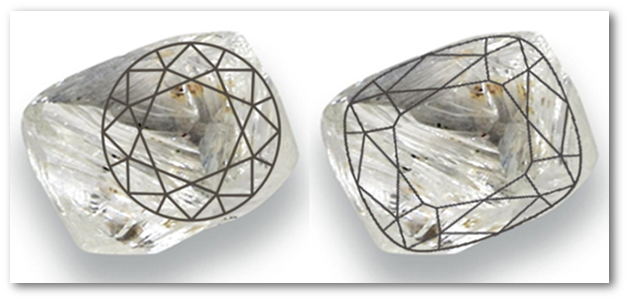
Can you see how much more “cushion” you can squeeze out of this rough diamond?
The round seems, and is, more expensive per carat once it’s polished. Keep in mind, the same rough diamond at the same cost price was used in both scenarios.
Finding your perfect round diamond is easier than you would imagine.
Luckily, most diamonds on the market are round – so your options are considerably larger than they would be when hunting for any other diamond shape.
The best starting point would be to browse our latest special offers.
You can find our latest diamond specials here in the respective budget ranges: R15 000, R30 000, R50 000, R70 000 and over R100 000.
There’s aren’t any duds on the list. They’re all stunning and excellently priced.
Looking for something very specific?
Our Special Order system is straight forward. Unfortunately, we can’t stock every shape in every colour, clarity and cut grade. That would be over 400 000 combinations without taking weight into account. So, we obsessively work through the daily stock-lists we receive from our mega-factory suppliers abroad and cherry pick the best deals from literally thousands of options. Some of these factories add over 1000 diamonds to their inventory every single day.
Whatever you’re looking for, we can find it, get some photos and information over to you, and if you like it we simply import it with our next batch. The quality and prices are staggeringly good.
Visit us in Rosebank or Pretoria
Seeing diamonds in person is awesome fun.
Elements like colour are close to impossible to demonstrate on a digital screen of any kind.
Why don’t you visit one of our studios in Pretoria and Johannesburg? Have some nice coffee, talk to a designer, see some design and diamond options. You’ll have a great time.

One last very important thing: Whenever we receive new diamond shipments, we mail out the options to our mailing list, 48 hours before they land on the website. The best deals are usually snapped up in this “early access” timeframe. Get on the list HERE.
Take care.
Johan Poggenpoel, Co-Founder.
T; 012 111 0525 (Pretoria) | 010 020 6811 (Johannesburg)
E; info@poggenpoel.com
Instagram:https://www.instagram.com/poggenpoeljewel/
Facebook; www.facebook.com/poggenpoel


